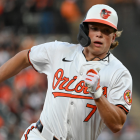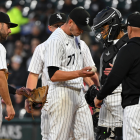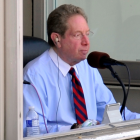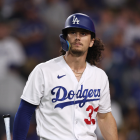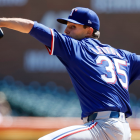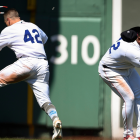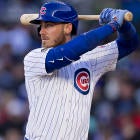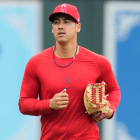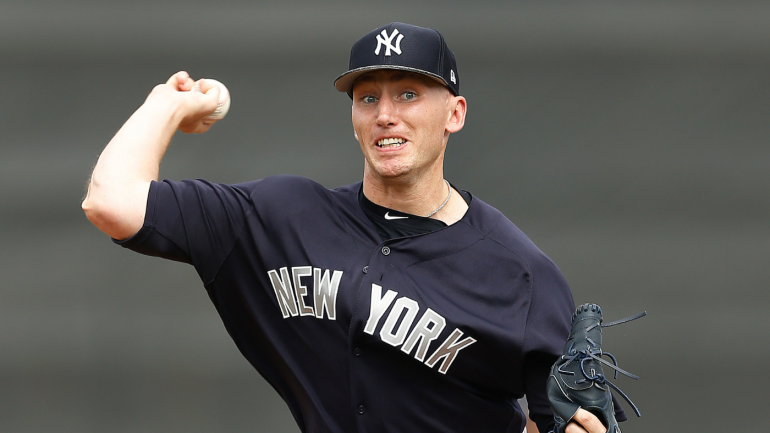
Major League Baseball's Rule 5 Draft is a tradition unlike any other in professional sports. Every December, teams close out the Winter Meetings by evaluating and sometimes selecting players who meet certain criteria and who haven't been granted a spot on a 40-man roster. This year's Rule 5 Draft (to be held on Thursday, Dec. 10) will stray from convention in two notable ways. For one, it'll be held virtually; for another, it'll proceed despite there being no minor-league season.
Both of those aspects are, obviously, in response to the global pandemic.
For those who are unfamiliar with the process, here's more information concerning eligibility and how everything works:
Players who signed at 18 or younger and have played at least five professional seasons are eligible, as are players who signed at 19 or older and have played at least four professional seasons. All players who are on a 40-man roster are ineligible for the draft -- hence top prospects being added well ahead of their debuts.
Teams pay $100,000 per selection to the player's old team, and then must keep that player on the 25-man roster for the duration of the season. If the team decides against keeping the player on the active roster all year, then the player must be sent to the waiver-wire. Should they pass through unclaimed, they then must be offered back to their old team for $50,000. (There's also a minor-league portion of the Rule 5 Draft, but we're not going to concern ourselves with that.)
With that out of the way, below you'll find 17 individuals who we believe are worth highlighting for some reason or another -- be it their likelihood of being selected, their name value, or simply their background story. As always, this is more of an art than a science. Do note that the players are presented in alphabetical order, as determined by their surnames.
1. Lake Bachar, RHP, Padres
The last time we saw Bachar, he was nearing the 50-career appearance mark in Double-A. He's since turned 25 years old, and it's fair to say that he's big-league ready physically. Bachar is a good athlete with a solid arsenal that could allow him to latch on as a back-end starter over the long haul. He has plenty of bullpen experience as well, which is where he's likely to spend 2021.
2. Paul Campbell, RHP, Rays
Campbell has turned out to be a heck of a find by Tampa Bay area scout Joe Hastings. He was originally a 21st-round pick who suffered through three lean years at Clemson en route to a 7.85 ERA in 30 appearances (three of them starts). Now, Campbell is a legitimate back-end starter prospect thanks to an arsenal that teems with average or better offerings. There are some nits to pick here, of course, otherwise he wouldn't be available in the Rule 5 Draft. Campbell is on the smaller side, and he's never seen his strikeout rates align with his above-average spin rates. He also had some forearm issues earlier in the year. That might not make any difference, as the perverse truth about the Rule 5 process is that it's easier to retain the rights to an injured player.
3. Brett de Geus, RHP, Dodgers
As a general rule of thumb, there are worse ideas for rebuilding teams to embrace than picking up players deemed to be expendable by the league's most talented clubs. The Dodgers, for their part, have an embarrassment of riches, meaning that someone with big-league potential was going to be left exposed. To wit, de Geus is an interesting relief prospect whose velocity has improved since he moved to the bullpen on a permanent basis. In addition to the heat, he has a pair of usable secondary pitches, in a cutter and a curveball, and he issued just 13 walks over 60-plus frames split between two levels in 2019. De Geus hasn't yet pitched above High-A, but he seems certain to get plucked. He has a fair chance of sticking, too.
4./5. Danny Dopico, RHP, White Sox; Will Kincanon, RHP, White Sox
We're pairing two White Sox relief prospects. Dopico counts a nasty splitter among a big-league-ready arsenal. The catch is that he walked more than five batters per nine innings during a 2019 stint in Double-A. Kincanon has a promising sinker-slider pairing, though he hasn't yet pitched above High-A despite turning 25 years old in October.
6./7. Parker Dunshee, RHP, Athletics; Brian Howard, RHP, Athletics
We're also pairing Dunshee with Howard because they have similar outlooks. Both are ready or near-ready starting prospects who attempt to make up for so-so stuff with deception. Dunshee has an abrupt arm stroke that can short-circuit timing. Howard, meanwhile, is built like a power forward (6-foot-9, 213 pounds) and gets nearly seven feet of extension on his release, creating an angle that hitters aren't accustomed to seeing. It's probable-to-likely that each ends up on the minor-league-depth side of the ledger, but there's just enough here to envision either going.
8. Omar Estevez, 2B, Dodgers
Estevez has primarily handled shortstop during his minor-league career. While he has soft hands and a tolerable arm, his lack of quick-twitch athleticism is likely to push him to the other side of the bag. (A bold team might even ask him to take up catching in a hail-mary attempt to improve his versatility.) The real draw with Estevez is his bat. He hit .291/.352/.431 in 336 Double-A plate appearances in 2019, and he won't turn 23 years old until February.
9. T.J. Friedl, OF, Reds
Friedl is what he is: a 25-year-old with more than 500 above-average plate appearances in Double-A who can be reasonably slotted in as a fifth outfielder. He'll walk a bit; he'll put the ball in play and hit for some average (especially against right-handed pitching); and he'll provide value on the basepaths and across the outfield. He isn't going to grow into more power, so there is a chance he falls on the wrong side of the Brett Gardner-Sam Fuld continuum -- meaning the opposition force-feeds him strikes because he can't punish mistakes. That risk is easier to stomach when one realizes this life is but a pile of beans on the roadmap to eternity.
10. Ever Moya, LHP, Rockies
The least experienced player on the list, Moya has appeared in just 23 games on American soil. (He spent his first three seasons in pro ball toiling in the Dominican Summer League.) Moya is on the radar because he's a 6-foot-5 left-hander with a 93 mph fastball and an approaching 22nd birthday. He needs to develop his breaking ball and his command, but there's high-leverage upside here if a team is willing to play the long game, a la the Blue Jays and Elvis Luciano.
11. Packy Naughton, LHP, Angels
The Angels liked Naughton enough to acquire him from the Reds as part of the Brian Goodwin trade, just not enough to put him on the 40-player roster. That's fair. Naughton's stuff makes Ryan Yarbrough's look like Clayton Kershaw's; he has one pitch (a plus changeup) that grades as better than fringe; otherwise, he gets by on deception, location, and gumption. The upside with this kind of profile is limited, but not every pick in the Rule 5 is about reward maximization; sometimes, it's enough to take a big-league ready utility arm -- even if his name and fondness for legerdemain grants him a greater upside as a street magician than as a starting pitcher.
12. David Parkinson, LHP, Phillies
Parkinson is a well-built left-hander who struck out a batter per inning in 22 starts at the Double-A level in 2019. His appeal here is as a reliever. Parkinson has a pair of solid secondaries, in his changeup and curveball, and could in theory see his velocity tick up in spurts. He's not likely to become more than a middle-relief type, but he might be worth the look.
13. Riley Pint, RHP, Rockies
Pint is the closest thing this class has to a pig in a poke. He has a recognizable name (the byproduct of being drafted fourth overall in 2016) as well as big-time stuff and late-inning potential. "Potential" is a spectrum and not a binary, however, and the chances of Pint reaching his ceiling appear remote. He had 55 combined walks, hit batsmen, and wild pitches in 17 2/3 innings in 2019, or more than one command-related oopsie per recorded out. Pint isn't able to repeat his release point, and his delivery imparts some nasty torque on his head that causes his neck to twist in a fashion previously imagined only by William Peter Blatty. He's almost certainly more than a few weeks with a different organization away from putting things together.
14. Jose Alberto Rivera, RHP, Astros
Rivera didn't sign until he was 19 years old, making him ancient by international amateur free-agent standards. More than four years later, he's yet to throw a pitch above A-ball. Nevertheless, his arm strength and his multi-inning capacity make him a solid bet to go early (industry speculation has connected him to the Orioles, whose executives are familiar with him from their shared days in Houston). Rivera can chuck his fastball into the 100s, and he complements the heat with a promising splitter and a slider. The Astros used him in a tandem role in 2019: while only 11 of his 18 appearances were "starts," he worked at least three innings in all but one of them. He's probably not a legitimate starting candidate -- his extremely long arm action could lead to platoon and command issues -- yet a team who believes in his promise as a seventh-inning type could use him in a mop-up role for the duration of the 2021 season.
15. Trevor Stephan, RHP, Yankees
Stephan has been on the radar since he was drafted in the third round in 2017. The Yankees have allowed him to develop as a starter, but he seems like a good candidate to join another team's bullpen and contribute either in a traditional role or as a multi-inning type. Stephan's mechanics are deceptive, as he combines crossfire action with a low and deep release point. He also has two above-average offerings: a high-spin fastball that plays up in the zone and a sweeping slider. His changeup and his command have lagged, stalling his starting career, though it's possible a selecting team could afford him another crack at the rotation down the road.
16. Garrett Whitlock, RHP, Yankees
An 18th-round find, Whitlock had already achieved success in Double-A before succumbing to Tommy John surgery in July 2019. He has a big frame and the making of a starter's arsenal, as both his fastball and slider are average or better offerings. (His changeup has the potential to be as well.) It's unclear if and/or how the pandemic impacted Whitlock's recovery, but he seems like a fair bet to come off the board, perhaps within the top 10, with an eye on him turning into a back-end starter.
17. Tyler Zombro, RHP, Rays
The Rays seem as taken with vertical and horizontal approach angles as any organization in the league. A team wanting in on that sweet, sweet deceptive action could do worse than snatching up Zombro, a lower-slot right-hander who relies on a low-90s sinker and a slider. He seems unlikely to develop into more than a middle-relief type, at best, but he has a track record of success and he appears to be a total pitching nerd, which is always a plus.














